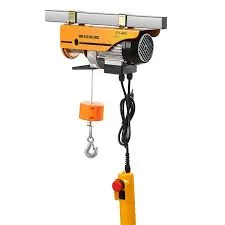


Designing an Efficient Chain Hoist Key Features and Considerations
The design of a chain hoist, an essential piece of equipment used in various industries, must combine efficiency, safety, and user-friendly functionality. Chain hoists are widely utilized for lifting heavy loads in manufacturing, construction, and warehouse operations. Their design is crucial not only for operational efficiency but also for ensuring worker safety and minimizing the risk of load failure.
Understanding the Basics of Chain Hoists
A chain hoist consists of several key components the chain, lifting mechanism, hook, and frame. The primary function of a chain hoist is to lift and lower heavy objects by using a chain that wraps around a drum or sprocket. The operator can easily control the ascent and descent of the load using a hand chain or an electric motor.
Factors Influencing Design
1. Load Capacity One of the most critical aspects of chain hoist design is determining the load capacity. The design must cater to specific lifting weights and should be able to handle loads safely without compromising integrity. Ensuring that the materials used in the construction of the hoist can withstand maximum loads is paramount.
2. Safety Features A well-designed chain hoist incorporates various safety features. These can include overload protection systems, which prevent lifting loads beyond the hoist’s rated capacity, and braking systems that can hold the load in place if the power supply is interrupted. Additionally, incorporating safety latches on hooks minimizes the risk of accidental disengagement of the load.
3. Durability and Maintenance The materials used in a chain hoist's construction also play a crucial role in its durability. High-quality steel is commonly used for chains and hooks to ensure strength and resistance to wear. Regular maintenance is also a design consideration. A good chain hoist allows easy access to components for inspection and repair, ensuring that downtime is minimized.
4. Portability In many industrial settings, a hoist must be portable to accommodate different lifting tasks. Therefore, the design should consider weight and ease of transport. Features like foldable frames or compact designs enhance the hoist's portability, making it convenient for operators to use in various locations.

5. Operating Mechanism The design of the lifting mechanism greatly influences the ease of operation. Manual chain hoists require a hand chain to lift loads, while electric models utilize motors. The chosen mechanism should align with the intended use-case, weighing factors such as the frequency of use, required lifting speed, and operator strength.
6. Environmental Considerations The working environment can significantly impact the design of a chain hoist. For instance, hoists used in outdoor construction sites must be resistant to corrosion and weather elements. Designs that include weatherproofing features or adjustable configurations to cater to various environmental conditions are critical for longevity and reliability.
7. Compliance with Standards Lastly, meeting industry standards and regulations is crucial in chain hoist design. These regulations ensure that the hoists are safe and reliable. Designers must consider local laws concerning lifting equipment safety, including the American National Standards Institute (ANSI) and the Occupational Safety and Health Administration (OSHA) guidelines.
Emerging Trends in Chain Hoist Design
Technological advancements are also playing a significant role in influencing the design of chain hoists. For example, manufacturers are increasingly integrating smart technologies into hoists. Features like load monitoring systems, remote operation, and data logging capabilities enhance safety and efficiency.
Additionally, ergonomic designs are gaining attention. Operators often work long hours using hoists, so designing controls and handles that minimize strain can significantly enhance user comfort and efficiency.
Conclusion
The design of a chain hoist is a multifaceted process that requires attention to load capacity, safety features, durability, portability, the operating mechanism, environmental considerations, and compliance with standards. As industries continue to evolve, the design of chain hoists must adapt to incorporate technological advancements while maintaining a focus on safety and efficiency. A well-designed chain hoist not only enhances operational productivity but also ensures the safety of all personnel involved in lifting operations. Whether for industrial, commercial, or construction purposes, investing in a quality chain hoist design is essential for any lifting application.



